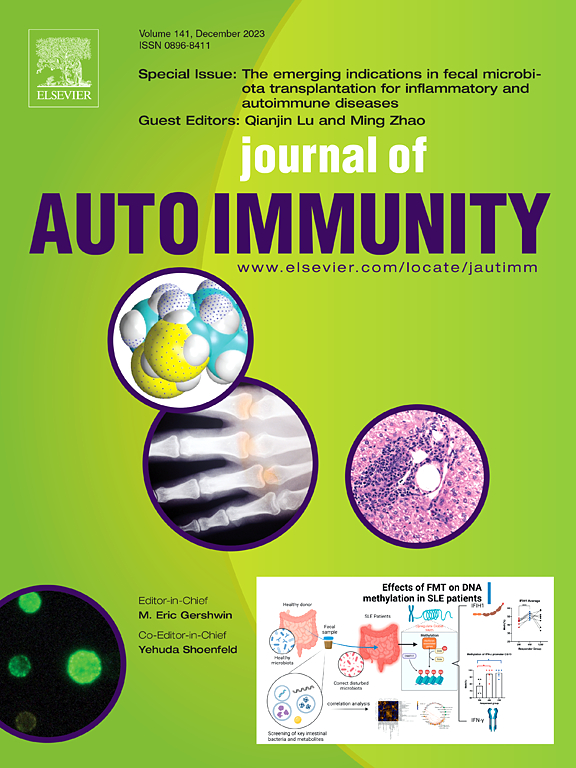eb病毒感染对免疫介导性疾病患者免疫细胞基因调控的影响
IF 7
1区 医学
Q1 IMMUNOLOGY
引用次数: 0
摘要
已知eb病毒(EBV)在初次感染后可潜伏感染免疫细胞,流行病学研究表明其与免疫介导性疾病(IMDs)的发病有关。然而,EBV感染对IMDs病理的具体影响尚不清楚。我们使用504名供者的大量RNA测序数据,量化了IMD患者和健康对照(HC)中B细胞亚群(Naïve B细胞、未开关记忆B细胞、开关记忆B细胞、双阴性B细胞和浆母细胞)的EBV载量。与HC相比,IMD患者的EBV载量明显更高。此外,该数据集中EBV负载的广泛范围使我们能够评估EBV负载对基因调控的影响。我们发现了许多与eb病毒载量相关的表达数量性状位点(eQTL)的例子。随着EBV载量的增加而表现出更大影响的表达qtl与来自EBV基因组的转录因子的结合位点显著重叠。这些EBV负载相关的eqtl显示出系统性红斑狼疮(SLE) GWAS信号的高富集,表明EBV感染与疾病的发病通过基因调控存在机械联系。这些发现为EBV感染对人原代细胞基因调控的影响及其与SLE发病和/或进展的关联提供了第一个证据。本文章由计算机程序翻译,如有差异,请以英文原文为准。
Effect of Epstein-Barr Virus infection on gene regulation in immune cells of patients with Immune-Mediated Diseases
It has been known that Epstein-Barr virus (EBV) can latently infect immune cells after the initial infection, and epidemiological studies have suggested its association with the onset of immune-mediated diseases (IMDs). However, the specific impact of EBV infection on IMDs pathology remains unclear. We quantified EBV load of B cell subsets (Naïve B cells, Unswitched memory B cells, Switched memory B cells, Double negative B cells, and Plasmablasts) in IMD patients as well as healthy control (HC) using bulk RNA sequencing data of 504 donors. The EBV load was clearly higher in IMD patients compared to HC. Furthermore, the wide range of EBV load in this dataset enabled us to assess the impact of EBV load on gene regulation. We found many examples of expression quantitative trait loci (eQTL) whose effects were associated with EBV load. Expression QTLs that exhibited larger effects with increasing EBV load were significantly overlapped with binding sites of transcription factors derived from the EBV genome. These EBV load-associated eQTLs exhibited high enrichment of systemic lupus erythematosus (SLE) GWAS signals, suggesting the mechanical link of EBV infection and the onset of the disease via gene regulation. These findings provide the first evidence of the influence of EBV infection on gene regulation in human primary cells and its association with the SLE onset and/or progression.
求助全文
通过发布文献求助,成功后即可免费获取论文全文。
去求助
来源期刊

Journal of autoimmunity
医学-免疫学
CiteScore
27.90
自引率
1.60%
发文量
117
审稿时长
17 days
期刊介绍:
The Journal of Autoimmunity serves as the primary publication for research on various facets of autoimmunity. These include topics such as the mechanism of self-recognition, regulation of autoimmune responses, experimental autoimmune diseases, diagnostic tests for autoantibodies, as well as the epidemiology, pathophysiology, and treatment of autoimmune diseases. While the journal covers a wide range of subjects, it emphasizes papers exploring the genetic, molecular biology, and cellular aspects of the field.
The Journal of Translational Autoimmunity, on the other hand, is a subsidiary journal of the Journal of Autoimmunity. It focuses specifically on translating scientific discoveries in autoimmunity into clinical applications and practical solutions. By highlighting research that bridges the gap between basic science and clinical practice, the Journal of Translational Autoimmunity aims to advance the understanding and treatment of autoimmune diseases.
 求助内容:
求助内容: 应助结果提醒方式:
应助结果提醒方式:


